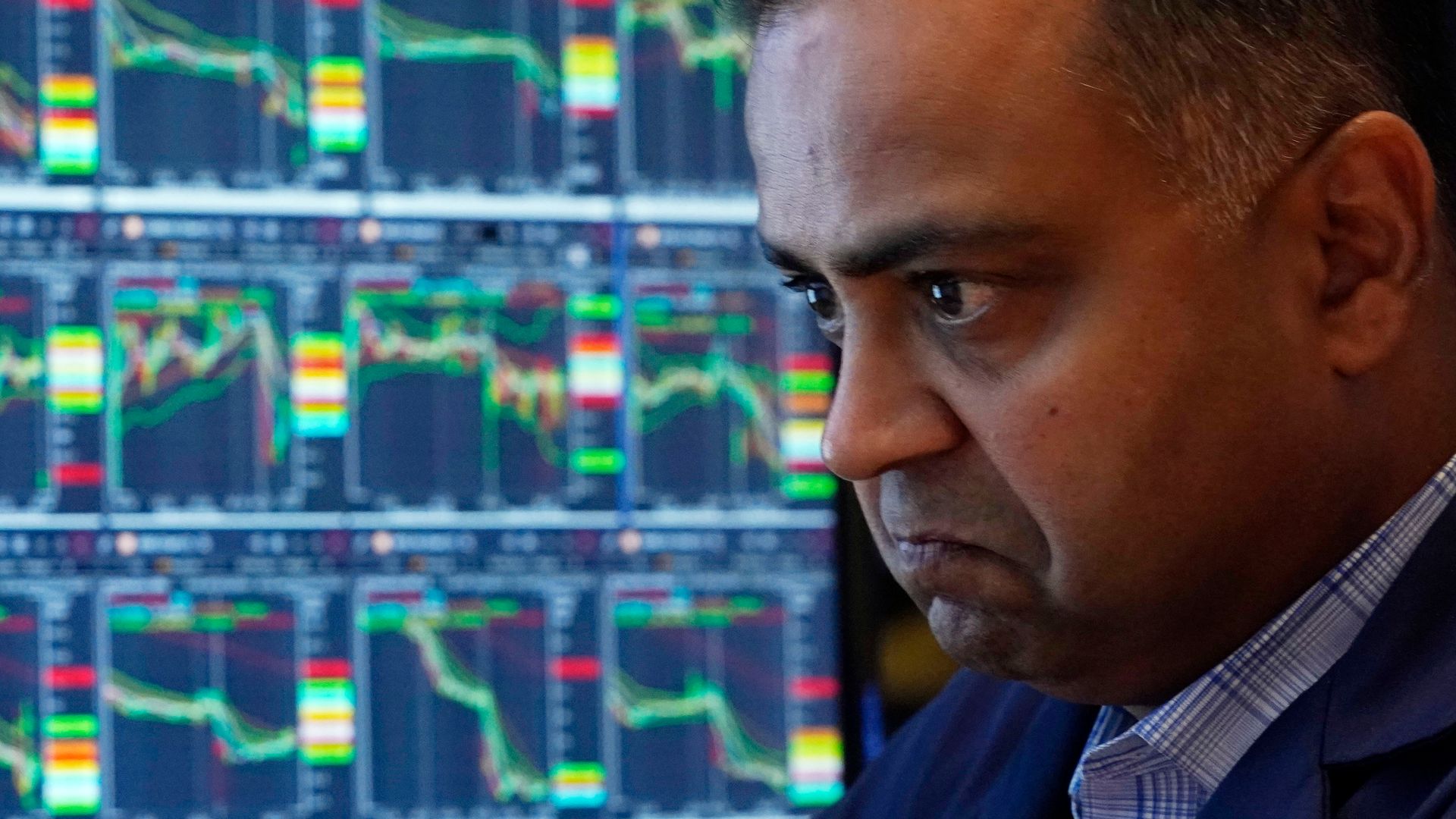
Overreaction or rational? Here’s why the US stock market plunged Monday.
By Simone Del Rosario (Business Correspondent), Brent Jabbour (Senior Producer), Emma Stoltzfus (Editor)
Investors slammed the sell button the morning of Monday, Aug. 5, with the Dow Jones Industrial Average sliding more than 1,000 points before the opening bell. The tech-heavy Nasdaq lost 6% while the S&P 500 was down more than 4% before the stock market opened.
Media Landscape
See how news outlets across the political spectrum are covering this story. Learn moreBias Distribution
Left
Right
Untracked Bias
The global sell-off started overseas in Japan with the Nikkei index having its worst day since 1987’s Black Monday crash. On Monday, the Nikkei plunged 12.4%.

Download the SAN app today to stay up-to-date with Unbiased. Straight Facts™.
Point phone camera here
It was Tokyo traders’ first chance to react to Friday’s U.S. jobs report, where unemployment unexpectedly spiked to 4.3%, triggering a U.S. recession indicator.
Japan’s rout was contagious and U.S. markets slid further Monday than their own initial reaction Friday, when the S&P fell 1.8%. On Monday, the market’s “fear index” surged to levels not seen since spring of 2020.
There is no doubt the sell-off is sparked by recession concerns from the jobs report and worries the Federal Reserve is way behind the eight ball when it comes to cutting rates.
“The Federal Reserve is at real risk of missing the boat, of being too late to the game when it comes to making sure that jobs continue to grow and that workers have good opportunities in the labor market,” former Acting and Deputy Labor Secretary Seth Harris told Straight Arrow News on Friday.
Harris said the disappointing jobs numbers are a warning sign but not a sign of recession.
“We’re beginning to hear from folks on Wall Street, the R word, the discussion of recession,” Harris said. “Now, I don’t think that this report tells us that we’re headed for recession. But as folks on Wall Street begin to start talking about it, that can become a downward spiral as it becomes a decision-making point for businesses.”
“If you think that we’re going to shrink – if the economy is going to slow and shrink – you don’t invest in hiring people, you don’t invest in capital equipment, you don’t invest in expansion, you don’t invest in inventories,” Harris continued. “And so that is the concern.”
In the case Harris describes, negative conditions can become a self-fulfilling prophecy. Will cooler heads prevail? Many assessments of Monday’s sell-offs are that it is an overreaction to the data. But it is not just the labor market and Fed actions feeding into it.
Unbiased news.
Directly to your inbox. Free!
Learn more about our emails. Unsubscribe anytime.
By entering your email, you agree to the Terms & Conditions and acknowledge the Privacy Policy.
For some time, investors worried tech stocks are overinflated this year, and over the weekend, Warren Buffett’s Berkshire Hathaway announced it sold nearly half its Apple stock in the second quarter. Apple started the day down 8% and dragged down Nvidia and other tech stocks with it.
Bitcoin also fell from around $62,000 Friday night to briefly under $50,000 Monday morning.
“Bitcoin doesn’t look like The New Gold,” Bloomberg Reporter Joe Weisenthal wrote. “It looks like 3 tech stocks in a trenchcoat.”
Simone Del Rosario: Investors slammed the sell button Monday morning, with the Dow Jones sliding more than 1,000 points before the opening bell. The tech-heavy Nasdaq lost 6% while the S&P 500 was down more than 4%.
The global sell-off started overseas in Japan, with the Nikkei index having its worst day since 1987’s Black Monday crash. On Monday, the Nikkei plunged 12.4%.
It was Tokyo traders’ first chance to react to the U.S. jobs report Friday, where unemployment unexpectedly spiked to 4.3%, triggering a U.S recession indicator.
Japan’s rout was contagious and U.S. markets slid further Monday than their own initial reaction Friday, when the S&P fell 1.8%.
On Monday, the market’s “fear index” surged to levels not seen since spring of 2020.
There’s no doubt the sell-off is sparked by recession concerns from the jobs report and worries the Federal Reserve is way behind the eightball when it comes to cutting rates.
Seth Harris: The Federal Reserve is at real risk of missing the boat, of being too late to the game when it comes to making sure that jobs continue to grow and that workers have good opportunities in the labor market.
Simone Del Rosario: On Friday, I spoke with former deputy labor secretary Seth Harris about the disappointing jobs numbers, which he called a warning sign but not a sign of recession.
Seth Harris: We’re beginning to hear from folks on Wall Street the R word, the discussion of recession. Now, I don’t think that this report tells us that we’re headed for recession…But as folks on Wall Street begin to start talking about it, that can become a downward spiral, as it becomes a decision making point for businesses, if you think that we’re going to shrink, if the economy is going to slow and shrink. You don’t invest in hiring people, you don’t invest in capital equipment, you don’t invest in expansion, you don’t invest in inventories. And so that is the concern.
Simone Del Rosario: And in the case he’s describing, these things can become a sort of self-fulfilling prophecy.
Will cooler heads prevail? A lot of assessments out there conclude Monday’s market actions are an overreaction to the data.
But it’s not just the jobs market and Fed actions feeding into it.
For some time, investors have worried tech stocks are a bit overinflated this year, and over the weekend Warren Buffett’s Berkshire Hathaway announced it sold nearly half its Apple stock in the second quarter.
Apple started the day down 8% and dragged down Nvidia and other tech stocks with it.
And Bitcoin fell from around $62,000 Friday night to under $50k Monday morning. Bloomberg’s Joe Weisenthal writing, Bitcoin doesn’t look like The New Gold. It looks like 3 tech stocks in a trenchcoat.
For SAN I’m SDR.
Media Landscape
See how news outlets across the political spectrum are covering this story. Learn moreBias Distribution
Left
Right
Untracked Bias
Straight to your inbox.
By entering your email, you agree to the Terms & Conditions and acknowledge the Privacy Policy.
MOST POPULAR
-
 Getty Images
Getty Images
Judge allows CNN lawsuit potentially worth billions to continue
Read17 hrs ago -
 Reuters
Reuters
It’s a bird, it’s a plane, it’s the first video of Alef Aeronautics’ flying car
Watch 2:1318 hrs ago -
 Getty Images
Getty Images
Democrats in Congress receive lowest approval rating in Quinnipiac poll history
Watch 2:5919 hrs ago -
 Getty Images
Getty Images
AG Bondi reviewing Epstein documents for release, could hold client list
Watch 1:4820 hrs ago




